
Euphorbia mellifera, the Canary spurge or honey spurge, is a species of flowering plant in the spurge family Euphorbiaceae, native to Madeira and the Canary Islands. It is an evergreen shrub or tree growing to 2.5 m (8.2 ft) tall and broad, with narrow leaves up to 20 cm (8 in) long. In spring it produces brown, honey-scented flowers.

Laurel forest, also called laurisilva or laurissilva, is a type of subtropical forest found in areas with high humidity and relatively stable, mild temperatures. The forest is characterized by broadleaf tree species with evergreen, glossy and elongated leaves, known as "laurophyll" or "lauroid". Plants from the laurel family (Lauraceae) may or may not be present, depending on the location.

Lagoa do Fogo is a crater lake within the Água de Pau Massif stratovolcano in the center of the island of São Miguel in the Portuguese archipelago of the Azores. The highest lake located on the island of São Miguel, the region is protected by governmental regulation that does not permit any constructions around the lake.

Picconia is a genus of two species of flowering plants in the family Oleaceae, found in the laurel forests habitat of Macaronesia.

Juniperus brevifolia, the Azores juniper, is a species of juniper, endemic to the Azores, where it occurs at altitudes of 240–800 metres, rarely up to 1,500 m (4,900 ft). It is closely related to Juniperus oxycedrus of the Mediterranean region and Juniperus cedrus of the neighboring Macaronesian islands. It is threatened by habitat loss.

Picconia azorica, locally known as pau-branco, is a species of Picconia common to the majority of islands of the Portuguese archipelago of the Azores, where it is endemic. It can grow to a medium-sized tree, though it is usually found in the form of a shrub. It is threatened by habitat loss.

Agapanthus praecox is a popular garden plant around the world, especially in Mediterranean climates. It is native to the Kwa-Zulu Natal and Western Cape provinces of South Africa. Local names include agapant, bloulelie, isicakathi and ubani. Most of the cultivated plants of the genus Agapanthus are hybrids or cultivars of this species. It is divided into three subspecies: subsp.praecox, subsp. orientalis and subsp. minimus.
Pico da Vara is the highest mountain on the island of São Miguel, in the Portuguese archipelago of the Azores, and principal special protection of the Nature Reserve of Pico da Vara. The area around the mountain includes the largest remaining stand of the native laurisilva forest on the island, home to the critically endangered endemic Azores bullfinch.
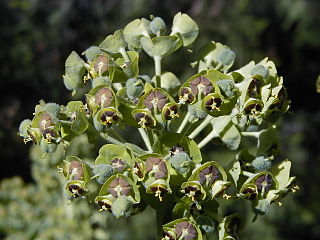
Euphorbia characias, the Mediterranean spurge or Albanian spurge, is a species of flowering plant in the family Euphorbiaceae typical of the Mediterranean vegetation. It is an upright, compact evergreen shrub growing to 1.2 m tall and wide.
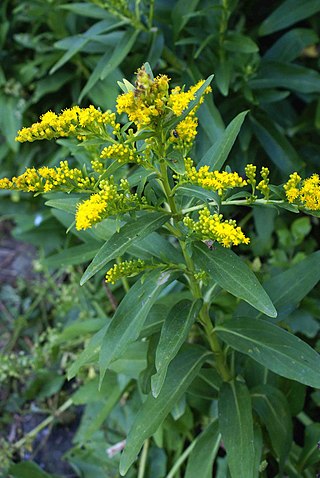
Solidago azorica is a species of goldenrod in the family Asteraceae, endemic to the Azores, Portugal. It is closely related to Solidago sempervirens, native to eastern North America, but in addition to the morphological differences there is a clear genetic separation between the two species. This species is thought to have evolved from its American relative from a natural introduction made well before human occupation on the islands.
Rubia agostinhoi is a climbing plant species of the Rubiaceae family endemic to the Azores It was defined by ecologist Pierre Dansereau and Pinto da Silva in 1977.

The Azores temperate mixed forests is a temperate broadleaf and mixed forests ecoregion of southwestern Europe. It encompasses the Azores archipelago in the Atlantic Ocean. These volcanic islands are an autonomous region of Portugal, and lie 1500 km west of the Portuguese mainland.

Baixo Islet, also known locally as Ilhéu do Carapacho and historically as Ilhéu dos Homiziados, is a small uninhabited islet group located off the southeast coast of the island of Graciosa in the Portuguese archipelago of the Azores. Along with Praia Islet to its north, Baixo Islet is one of two main breeding places of Monteiro's storm petrel, an endemic marine bird of the Azores.

Praia Islet is a highly vegetated uninhabited islet located approximately 1.5 kilometres away from the town of Praia off the eastern coast of the island of Graciosa in the Portuguese archipelago of the Azores. Along with Baixo Islet to its south, Praia Islet is one of two main breeding places of Monteiro's storm petrel, an endemic marine bird of the Azores.
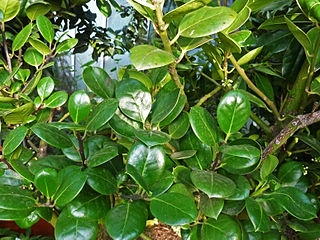
Ilex perado, the Macaronesian holly, is a species of holly endemic to Macaronesia, distributed throughout the Azores, Madeira and Canary islands. It is an important component of the natural high-altitude Macaronesian rainforest, known as 'laurisilva', found mostly at 500 to 1,200 m altitude but it also appears in forest formations at lower elevation. Many of the subspecies have been classified as threatened, probably because of very small population sizes, and are protected by local, national and regional legislation.
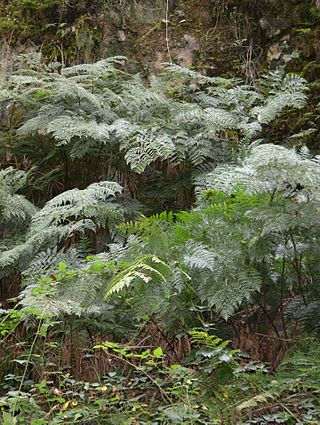
Culcita macrocarpa, the woolly tree fern, is a species of fern in the family Culcitaceae native to Macaronesia and parts of the Iberian Peninsula, where it might have been introduced. It is the only member of the order Cyatheales that is native to Europe.
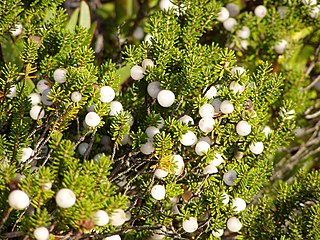
Corema album, the Portuguese crowberry ; Spanish: camarina, is a species of flowering plant in the family Ericaceae endemic to the Iberian Peninsula, Aquitaine, and the Azores (sub-species), where it may also be considered a different species. Its white berries are known to have been consumed by people in the Iberian Peninsula at least since the Middle-Ages. The only other species of the same genus is Corema conradii, found in North America.
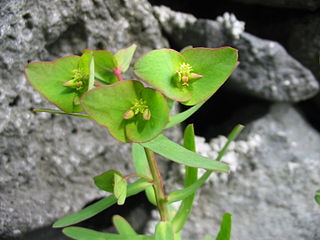
Euphorbia azorica is a species of flowering plant in the spurge family Euphorbiaceae, endemic to the Azores, Portugal.
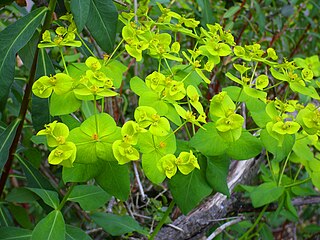
Euphorbia paniculata is a species of flowering plant in the spurge family Euphorbiaceae, native to the Iberian Peninsula and North Africa in the western Mediterranean Basin.
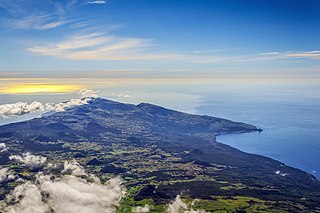
The Achada Plateau is an extensive volcanic mountain range located on Pico Island, Azores. It is a protected area with many valuable features that characterize the Azorean landscape. It is included in two Natura 2000 sites, one of which is classified as an Important Bird Area. Part of the plateau also includes a ramsar wetland. It is one of the three main geomorphological units that comprise Pico Island.























